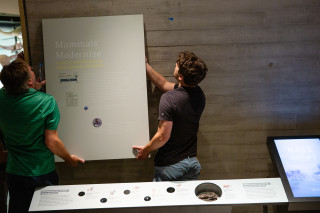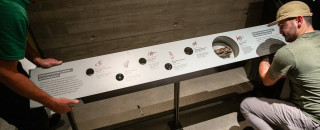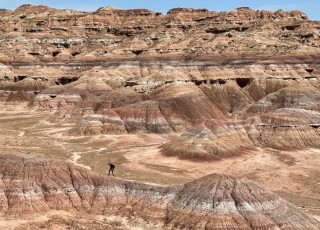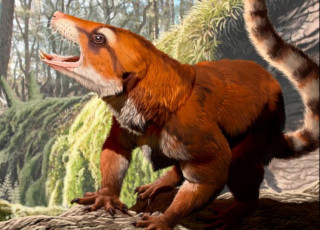How Mammals Changed During the Middle Eocene Climatic Optimum
By Jude Coleman
Mammals have roamed what is now North America for around 300 million years. But it took them nearly 250 million years to start looking like the animals we see today. That happened in the Eocene epoch, a time when the region was warm, humid, and lush with tropical forests.
Several times during the Eocene, mammals went through rapid diversification periods, where many new species emerged. These periods are correlated with two warming spikes, which scientists call climactic optimums: one that marked the start of the Eocene, and another 5 million years later. In the middle of the Eocene was a third warming spike, whose effects on mammal diversity have been a mystery — until now.
By compiling a detailed record of middle Eocene fossils, researchers are piecing together what happened to mammals during the third warming spike. The fossils of these mammals are mostly small — tiny teeth, miniature skulls — and come from the Uinta Basin. The Uinta Basin is a treasure trove of mammal fossils from the middle Eocene, said paleontologist Beth Townsend. Townsend, who teaches anatomy at Midwestern University in Glendale, Arizona, and her team are trying to figure out if, and how, mammals changed during the Middle Eocene Climatic Optimum (MECO).
Prior to the Eocene, the Uinta Basin was a massive lake. But by the middle Eocene, the lake had begun to recede, leaving in its place a network of rivers, similar to the Amazon. The sediment on the riverbanks was ideal for fossilizing whatever creatures died there.
For decades, scientists have known the Uinta Basin would hold fossils. Mammalian fossils from the middle Eocene are even called “Uintan mammals” as an ode to their ideal preservation in the area’s rock layer. But the first museum collectors to recover specimens were focused on large animals — things that would still draw patrons’ attention next to other awe-inspiring fossils, like dinosaurs and mammoths. That means the fossil record for both the area and time period was biased toward bigger fauna, and didn’t include as much of the smaller animals, such as rodents.
“The main fossils in the big museum research collections were medium-sized and large mammals,” said Townsend. “For a long time, people thought that the small mammals had essentially died out by this later middle Eocene time period.”
Over the last several decades, researchers have been trying to fill that gap in the fossil record. It was Townsend’s dissertation advisor, in fact, who spearheaded the movement to collect more small fossils from the Uinta Basin back in the 1990s. While the quest to continue finding more fossils remains, scientists have collected far more than there used to be. Now, Townsend can look for trends in those fossils.

Museum staff install the new MECO exhibit at NHMU. Photo by Mark Johnston
A new exhibit in the Natural History Museum of Utah’s Past Worlds gallery highlights Townsend’s work so far. The exhibit features several small, middle Eocene mammals from the Uinta Basin, including early relatives of tapirs and bush babies. Visitors can learn more about the middle Eocene ecosystem and the MECO, and play an interactive game that portrays how climate warming can impact mammal diversity.
Townsend hopes that from the fossils she and others have collected, she and her colleagues can learn how mammals responded to the middle Eocene warming spike, which happened over a span of 600,000 years. Although she’s still analyzing the data, she has a hunch it will reveal that diversification did happen. Once that question is answered, the next question is who diversified, and how. For example, past data from other warming trends show that as temperatures go up, rodents tend to get larger, while carnivores tend to get smaller.
“The interesting thing will be who diversifies; which taxon will it be,” said Townsend. “And how are they doing it? Are they getting bigger, are they getting smaller?”
Townsend’s research on fossils from the MECO is particularly relevant because the warming spike mirrors the scale of global warming occurring today: without any mitigation, the climate is projected to warm around four degrees Celsius by 2100, which is roughly the same as the temperature increase from the MECO. The big difference between the two events is their time span. While warming in the middle Eocene ramped up over hundreds of thousands of years, global warming today has taken place over a mere 200 years. That makes a huge difference in how mammals — and other organisms — are able to adapt.
When warming occurs slowly, natural selection and evolution have time to shape future generations of animals. That allows species to adapt to higher temperatures and other ecological changes associated with those temperatures, like food availability. But when warming happens rapidly, animals don’t have this opportunity. Particularly, animals that have fewer offspring or longer times in between giving birth, such as large carnivores, have even less of a chance to adapt than animals who frequently have higher numbers of offspring, such as small rodents.
The new Past Worlds exhibit features a Temple Run-inspired simulation that illustrates this concept. Users will first play as a carnivore attempting to survive and adapt to gradual climate warming and rapid climate warming. Then, they’ll play as a small mammal adapting to rapid warming.
“I think it’s going to be a highlight of this area,” said Lisa Thompson, an exhibit developer at the Natural History Museum of Utah who worked on the new MECO display. The takeaway of the exhibit is that mammals can diversify if they have time to adapt to warming temperatures, she said. If they don't have time to adapt, odds are higher they go extinct.
To find out how mammals responded to the middle Eocene warming spike, Townsend is relying heavily on teeth. Teeth can tell researchers how large the animals got and if their diets shifted at all. Dental data will also help reveal the different types of animals that evolved in the Uinta Basin at the time.
“It's going to change the story of what we know is going on in the middle Eocene for all of North America,” said Townsend. “It's going to be really exciting.”



